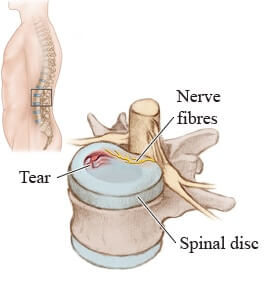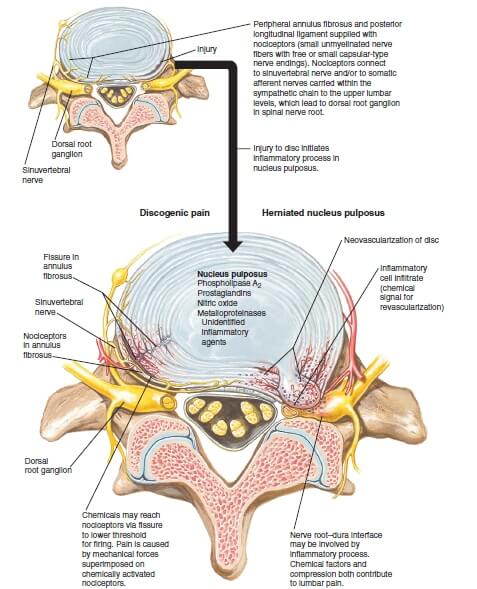Discogenic Pain
What is it?
Discogenic pain describes pain that arises from a failing intervertebral disc. Discs are the gel like cushions between the bones of the spine that help to bear the forces of walking and moving. As the body ages, the discs lose their normal water content and become degenerative and brittle. These degenerative discs can cause some slight movements or instability in the spine, which can lead to episodes of muscle spasm as the muscle tighten to support the movement. Usually a day or two of rest will help the back pain of acute muscle spasm. Degenerative discs can also cause pain by impinging on nerves that exit close to the spine resulting in Sciatica. It should be noted that not all degenerated discs cause pain. In fact, you can have a narrowed or herniated disc that does not cause discogenic pain at all. It is dependent on the impact the disc changes have on all surrounding tissues.

Who gets it?
Many different patient groups can experience discogenic pain. However, it tends to occur in middle age more frequently than in older adults. This is because, as the disc degenerates, the spine develops ways to compensate for the failing disc. Although you may have considerable pain in your middle years, by the time you reach older adulthood the spine has already employed strategies to stabilize the spine and reduce pain. Middle aged patients who meet certain criteria are more likely to have discogenic pain than others. For instance, patients who participate in contact sports can cause the disc to degenerate because of the pressures and impacts of the game. Poor ergonomics can also contribute to discs breaking down because this means the spine has to compensate for awkward body mechanics. Those who carry extra weight and those who have professions that require constant heavy lifting are also at risk due to the repetitive stress of both conditions.
What kind of pain results?
Discogenic issues can result in two different types of pain. First, muscular back pain may be present when a disc is damaged. This is because the disc keeps the vertebrae at a specific distance from each other. When the disc is damaged and loses height, the ligaments, tendons, and muscles that support the spine become sprain or strained. Localized back pain in the muscles is quite common from a degenerating disc, but it is not the type of pain that usually drives a patient to seek treatment. Nerve pain is generally the most insistent symptom that arises from discogenic issues. When the discs compress, the nerves that exit the spine become impinged (pinched nerve) by the lack of space between the vertebrae. When discogenic pain occurs in the neck causing neck pain, the arms and hands can suffer from numbness, shooting pain, tingling, and weakness (radicular pain). Similarly, when the compression occurs in the lower back, the legs are affected by the same types of sciatica symptoms. The nerve pain can range from intermittent, shooting pains to a constant ache that often resists conservative treatments.
Treatment
Most patients see their primary care physician when they first experience discogenic pain. Whether it is muscular pain or nerve pain, the discomfort usually prompts a visit to the family doctor. This provider may order x-rays, CT scans, or MRIs to determine the extent of the injury. Once discogenic pain is diagnosed, several professionals may be called upon to provide care. Chiropractors can help to realign the spine and help vertebrae to adjust to the new height of the disc. Physical therapy is also important to help condition the muscles impacted by the shifting pressures in the spine. Many patients also benefit from treatment by Pain Medicine physicians because they can often recommend possibilities to ease pain. Aside from neuropathic pain medications, such as antidepressants and anti-seizure drugs, pain management physicians can perform a discogram to evaluate each disc and determine which, if any, are causing pain. This procedure is usually done in anticipation a surgery to identify the painful disc. Intradiscal electrothermic therapy, or IDET, is a minimally invasive procedure that employs high temperatures to destroy nerve endings and toughen disc tissue. Finally, nucleoplasty, or discectomy, can be used to remove parts of the disc that are impinging on nerves. These procedures are done with needles, and do not involve surgical incisions.
When these measures are ineffective, you may need referral to a spinal surgeon. It is also necessary when extended conservative treatments do not change or nearly eliminate pain. In addition, pain that severely impacts a patient’s daily activities may require surgery much more quickly than moderate pain. Your spine surgeon will explain possible surgical options, the most common being a spinal fusion. However, surgery such as fusing of two or more bones of the spine is generally used only when all other methods have failed.




